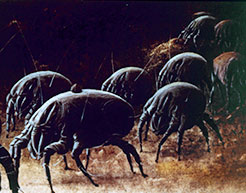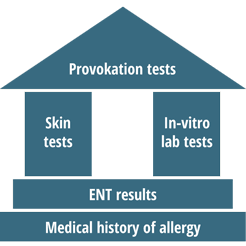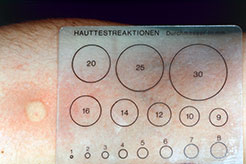Allergology
Allergen avoidance, diagnostics, therapy
An allergy is a specific alteration of the immune status resulting in a disease-causing oversensitivity. Our ENT practice group with the main focus on allergology offers you the whole range of diagnostics and therapy for allergic diseases induced by exposure through inhalation.
According to the latest surveys almost one in three people in the Western industrial nations suffers from an allergic disorder. Typical characteristics of an allergy of the upper and lower respiratory tract are symptoms like sneezing, runny or blocked/bunged up nose, itching, watery eyes as well as possible breathing problems (asthma).
If any of these symptoms are present, you should preferably see an allergist, who is qualified and specialised in allergy treatment. Our ENT practice group has the allergologic additional specialist qualification which involves a qualified further education lasting several years as well as further education in environmental medicine.
For this reason we can give you the advice and therapy you need if you suffer from allergies or eco-toxic disorders.
Advice on allergy avoidance

One gram of bedroom dust contains an average of 1,000 dust mites
Basically, the top priority of an allergy therapy should always be the avoidance of allergen exposure, the allergy avoidance. If you suffer from dust mite allergy, the use of special encasings for mattress and duvet covers can relieve allergy symptoms significantly.
We have compiled some helpful tips for hay fever sufferers:
- Do not stay outside for extended periods of time in dry windy weather and make sure you don't do any physical activity. Cycling, jogging, driving with an open window or top significantly increases allergy symptoms. It is better to do your workout in the gym or the indoor pool.
- Rain will initially lead to an increase of pollen concentration in the first hour as the pollen floating in upper air layers will be pushed down. After a few hours of continuous rainfall, however, the pollen will be washed out of the air and allergy sufferers can enjoy being outside again.
- Since the pollen concentration is at its peak between 3 and 6 o'clock a.m., you should not sleep with your bedroom window open. In rural areas it makes sense to air rooms thoroughly before going to bed as pollen concentration is at its lowest in the evening up to midnight. In city centres you should air rooms between 6 and 8 am.

- Furthermore, it is recommendable to leave clothes worn during the day in the bathroom and take a shower and wash your hair before going to bed to carry as little pollen as possible into the bedroom and bed.
- Particularly from early March to mid May when trees in Hessen shed their pollen you should be careful when consuming nuts and stone fruit because of a potential cross hypersensitivity to the botanically related food.
- Those who have enough time and money should go to the coast, into the high mountain region or into the desert during high pollen season.
Allergy diagnostics

Allergy diagnostics structure

Allergic skin reaction following prick test
To illustrate the system of allergologic diagnostics we have developed the "structure of allergy diagnostics".
A thorough inquiry of your allergy problems and symptoms (anamnesis) forms the foundation. Based on that is the endoscopic and sonographic ENT examination result of the lining of the membrane of the upper respiratory tract. Two pillars are based on this foundation that support the structure of allergy diagnostics:
One pillar forms the various skin tests which can be done in different forms like rub test, scratch and prick tests and intracutan testing.
The second pillar represents the various in-vitro lab tests, where the specific antibodies in the blood are analysed. (Total-IgE, specific IgE).
We have our own comprehensive allergy specialist laboratory with appropriate analysis qualification (recognised by all healthcare insurers).
Finally, specific issues require the so-called nasal provocation tests carried out on the mucous membrane. Since these are of high diagnostic value, they represent the "roof" at the top of the "allergy structure". In this test the actual allergy path is simulated straightforward by spraying the highly diluted allergen (e.g. highly diluted grass pollen extract) straight into the nose causing a mild allergic reaction and the subsequent respiratory flow can be measured with a nasal mask.
This range of diagnostic instruments allows the early diagnose of a potential allergy given any difficult differential diagnosis case and is the precondition for the induction of an allergy therapy tailored to the patient's needs.
Therapeutic options in the treatment of an allergy
The trivialisation of allergies through health strategic requirements determined by the government over the past few years even lead to a rise of inadequate therapy of allergy sufferers in Germany. A purely symptom-based therapy (often self-treatment) frequently improves health insufficiently and partly goes along with side effects. This cannot keep the allergy from spreading within the body.
A common mistake made by allergy sufferers is to treat any physical discomfort only insufficiently or not at all which causes a number of allergy cells to move from the blood straight to the lining of the mucous membrane. Through this - known among allergy specialists as "nasal priming effect" - mucous membranes become more sensitive and the patient suffers more severely and more frequently throughout the whole pollen season. The reason is that even shrinking amounts of pollen can induce an allergic reaction.
Due to the frequent insufficient treatment of allergies about one third of patients suffering from pollen allergies will start developing symptoms in the lower respiratory tract. Allergic discomforts will drop from the eyes and nose area to the pharynx and bronchial tubes. Respiratory disorders and frequent tissue proliferation in the nasal tissue may occur culminating in adenoids and sinus polyps and chronic sinus problems.
This development can, however, be counteracted at an early stage with the so-called specific immunotherapy (SIT), an immunobiological treatment. Backed up by the confirmation of the WHO the SIT is the only causal treatment option of an allergic disease. Consequently, the specific immunotherapy is the only current therapy that offers the real chance of curing an allergy.
We will be happy to advise you on the different allergologic therapy options tailored to meet any individual needs.

